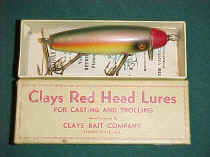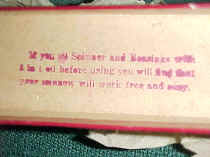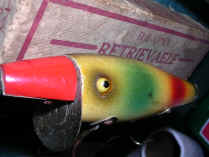Clays Red Head Lures, Thomasville, Ga. The South claims few true classic lures, but the spring-loaded Clays Red Head lures made by Thelma H. Clay in the late 1920s can hold their own against any early maker. These hollow lures have an internal spring that enables the head to pull away from the body when snagged, then snap back, hopefully unsnagging the lure. |
 |
|
Vann-Clay Retrievable Minnow The Vann Clay Retrievable Minnow was the first name used for Clay's lures, and this is the earliest, and perhaps the hardest to find, of the three boxes manufactured by this famous Georgia company. This spring-loaded Vann-Clay Retrievable Minnow lure was found, for almost nothing, at the Shipshewanna Flea Market in northern Indiana. |
 |
|
Retrievable Vann Clay Minnow These fine Vann Clay Retrievable Minnow lures were found in Kentucky. Note the directions explaining the de-snagging feature, and the closeup of the unique Vann Clay hardware, which utilizes a crimped metal pin attached by an oval-shaped brass plate. These came from a visitor to this website. Vann Clay lures are Georgia's finest classics! |
 |
 |
|
 |
|
Clays Dynamic Lures, Thomasville, Ga. After World War II, T.H. Clay continued to make lures, but limited production to painted eye and tack eye baits. This wonderful Clays torpedo lure with bulging tack eyes is one of four known, and was acquired from Sonny Clay, T.H. Clay's late son, who was a member of the National Fishing Lure Collectors Club. |
 |
Clays Dynamic Lures, Thomasville, Ga. Here is a more typical Clays Bait Co. Torpedo lure, which was acquired by from a visitor to this website who took it in at a South Georgia paw shop of all places. Note the painted eyes (not tack eyes like the example above). Most Clay lures made after WWII have a unique V-shaped red chin blush. |
 |
Clays Bait Co.. Thomasville, Ga. Here is yet another boxed 1940s-era Clays Dynamic Lures wooden minnow from the same "pawn shop" find discussed above. Note the unusual pink shore paint pattern that resembles Heddon paint jobs of the period. Clay lures often imitated the major tackle makers' products . Clay even made a lookalike to the Creek Chub Wigglefish! |
|
Clinton Wilt, Springfield, Mo. This classic 1912 barberpole bait is called the Little Wonder Minnow and features a nickel-plated lead ballast weight and a finely machined three-blade prop. This "Pat. Applied For" box is the only one I've seen. All Clinton Wilt baits are wonderful. This company made a larger bait called the Champion Minnow. |
 |
|
The Little Wonder was patented Sept. 16, 1913, and is thought by some to have preceded the larger Champion. Although no paperwork has been found for either lure, the directions printed in the box bottom suggest that the spinner and its related internal bearings be carefully oiled to insure that this heavy bait runs "free and easy." After more than 90 years in this box, this particular example runs just fine. |
 |
 |
|
Comstock Weedless, Valparaiso, Ind. F.E. Comstock applied for a patent for this lure in 1923. By the time the patent was granted is May 1926, the "Chunk" had become the property of the Moonlight Bait Co., which renamed it the "99 Percent Weedless." Thus, we can date this "patent applied for" box between 1923 and 1926. The Comstock Weedless had a lead keel. |
 |
Cornelius Lie Patent Bait Little is known about the intricately machined Cornelius Lie patent bait, dated 1885. It is a spring-loaded mechanical metal lure with embossed, painted, lifelike detail. Spring loaded hooks were popular long before wooden lures came along. This spring loaded lure is also known as a "gorge hook" and was acquired from a visitor to this website. |
|
Cumings Minnow, Flint, Mich. Ed Cumings aka Ed Cummings offered a line of lures, nets and other supplies in the early to late 1930s. His bentwood landing nets are very popular, as are his well-made lures. This Feathered Casting Minnow resembles a Heddon Wilder-Dilg flyrod lure, but the Ed Cumings or Ed Cummings bait has a head made of lead - not cork. |
 |
Ed's Hula Hula, Ed Cummings Ed Cumings or Ed Cummings also made this unusual and rare Ed's Hula Hula bait in the 30s. It has a wooden body, very tiny glass eyes and dyed chicken feathers. The Ed's Hula Hula lures are the hardest to find of all the Ed Cummings products. Ed Cumings and Ed Cummings both mean the same person, but the spellings are often interchanged or confused. |
 |
Darby Weedless Bait, Indiana This contraption was co-patented by brothers Tony and Mike Darby of Whiting, Ind., in the late 20s or early 30s. The spring loaded Darby Weedless Bait featured a rotating head with metal fins, unique machined hooks and twin "triggers" that caused the hooks to spring open like a switchblade knife when a fish struck. This lure was no doubt deadly - to any angler daring enough to attempt to use it! |
|
Darby Spin Head Weedless The Darby brothers briefly partnered with a man named Morrison in Chicago, who overlabeled the boxes with a Morrison Bait Co. label. Beneath them, however, is the standard Spin Head Weedless from Whiting, Ind. This rare lure sold for $2 - a tidy sum in its day compared with other baits of that era. These two mint lures were acquired from a great grand-niece of Tony Darby, whom we first met as a visitor to this website. We are proud to present them here. |
|
|
Detroit Bass Caller, Detroit, Michigan The Detroit Bait Company offered these winged plunking type Detroit Bass Caller baits in the early to mid-1930s. The lures featured a scooped out place in the back that was supposed to make the water foam and gurgle - and annoy the fish! |
 |
|
Detroit Glass Minnow Tube These well-made, heavy glass lures were marketed around 1914 with the idea that a single minnow could live inside the Detroit Glass Minnow Tube all day and catch fish after fish. These valuable lures had German silver fittings. The two sets of papers inside describe how to use the lure, and mention a partnership with the South Bend Bait Company of Indiana. |
 |
|
Detroit Minnow Tube Glass This is a second version of the Detroit Minnow Tube lure that has a celluloid screw-on lid instead of the engraved metal plate shown in photo above. Thebox is slightly different, with no patent dates and no mention of "German Silver fittings." The two papers inside are for the Detroit Minnow Cage and the Minnow Tube. This one is unused and perfect. |
|
Detroit Minnow Cage, Detroit This unusual lure was sold in 1915 and featured a coiled series of wire forming a "cage" around the bait minnow. Only a handful of these rare picture boxes are known. The Cage was made by the Detroit Glass Minnow Company. Although these valuable lures are widely faked, this boxed example of a Detroit Minnow Cage is the real thing. |
 |
|
This eyeless wooden lure was made by Bignall & Schaff of Grand Rapids, Mich, prior to 1910. The papers tout the holes drilled into the body and the red-painted grooves that give this gemstone of a lure its wiggle. The Diamond Wiggler is one of the rarest lure boxes to be found in this collection. |
 |
Bill Dewitt Baits, Auburn, N.Y. These early plastic, or "pyralin" lures were made in great numbers by Bill Dewitt, Baits, a division of Shoe Form Co., which tinkered with early plastics. this Tango looking lure is almost ceramic in texture and would shatter if dropped. These lures date to the 1930s. Notice the unusual brass clip hook hardware. I don't know the lure's name. |
 |





